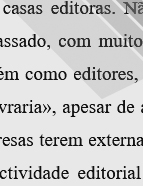

................................
Even so, from the mid- century onwards, there was a tendency to popularise books (an effort that was always conditioned by the high illiteracy rates). For example, cheaper popular collections were created, such as the "Livraria Clássica Portuguesa" [Portuguese Classical Bookshop"] by António and José Feliciano de Castilho, which anthologised texts by classical Portuguese authors with historical and literary introductions (M. L. Santos, Idem, 1985, pp. 229-230), or the "Biblioteca Económica" ["Economic Library"] by Eduardo de Faria, possibly the first to use the fascicle sales model. He also published an illustrated História de Portugal [History of Portugal] by Francisco Duarte de Almeida Araújo, in 80-page fascicles (A. Anselmo, Idem, 1997, pp. 143-145.) Additionally, with a view to their dissemination, he published other material such as "Educação Popular" ["Popular Education"] by Pinheiro Chagas (in the 1970s) and "Propaganda Democrática" ["Democratic Propaganda"] by Consiglieri Pedroso, both of which gave great importance to historical themes. Illustration was also used more extensively to capture more readers - a major focus for publishers of historical books, as can be seen, for example, in the second edition of Pinheiro Chagas' "popular and illustrated" História de Portugal, with 540 reproductions of engravings and 309 vignettes; or in the third, with illustrations by the renowned Roque Gameiro. (S. C. Matos, Historiografia...[Historiography...], 1998, pp. 155-161.) Others may also be mentioned, such as: "Pecúlio do Recreio", 200 novels published by Francisco Rolland and Semiond; "Livrinhos de Ouro" ["Golden Books"], by Castilho; and "Livros para o Povo" [Books for the People"], by A. Teixeira de Vasconcelos. (M. M. Tavares, Idem, 1999, pp. 199-200.)
The fascicles (or booklets, as they were called at the time) became the favoured means of getting the book to more people. Readers bought, collected and bound the fascicles, which arrived periodically on the market. It was a simple idea that allowed publishers to reduce their investment and the reader to purchase in instalments - through agents dispersed across the country selling what was being produced. This was the model followed, for example, by the Companhia da História de Portugal [History of Portugal Company], which distributed its publications thus, with some achieving remarkable success (A. Anselmo, Idem, 1997, pp. 143-149), namely the História de Portugal by Pinheiro Chagas and the História de Portugal by António Enes, through the Empresa Literária de Lisboa [Lisbon Literary Company], among others (6 illustrated volumes, 1876-1883). This format lasted in Portugal until the 1970s, making it possible to invest in larger works, in particular encyclopaedias and dictionaries (such as the Dicionário de História de Portugal [Historical Dictionary of Portugal], 1963-1971, by Joel Serrão, and the incomplete Grande Dicionário da Literatura Portuguesa e da Teoria Literária [Large Dictionary of Portuguese Literature and Literary Theory] 1977, by João J. Cochofel) without exhausting the companies' resources. (N. Medeiros, Idem, 2010, p. 164.).
